
08/08
|
09
Apretando el botón OPTION tres veces, puede
pasar del modo EMITIR (SEND) al modo OPCIÓN
(OPTION). Esto le permitirá cambiar entre las
funciones: Temperatura – Apriete SCAN para
cambiar entre ºC y ºF. Brújula – Cuando se
introduzcan pilas nuevas, la brújula tiene que
proceder a un calibrado interno. Esto también es
necesario si el dispositivo detecta fuertes variaciones
de temperaturas. Para iniciar el calibrado, apriete
SCAN (“CAL” parpadea). Dele al detector toda
una vuelta (por 360º). Finalmente, apriete el botón
OPCIÓN (OPTION). Brújula de marcación
(brújula localizadora de dirección con indicado de
flecha en la pantalla) – Puede cambiar la dirección
con SCAN. Seleccione la dirección de luz intermitente
apretando MARK (+) y SCAN (-). Para terminar
apriete OPTION. Altímetro – Puede adaptar el
altímetro a la presión del aire actual apretando
SCAN. Ajuste la altura que aparece en pantalla con
MARK (+) y SCAN (-). Para establecer el ajuste a
cero, apriete MARK y SCAN simultáneamente. Para
terminar, apriete OPTION.
Apretando el botón OPTION (mínimo 3 segundos),
puede volver al modo EMITIR. En el modo OPTION,
el detector no emite señales y por lo tanto vuelve
automáticamente al modo EMITIR después de dos
minutos. Si la batería tiene carga baja, vuelve al
modo EMITIR tras 30 segundos.
iIMPORTANTE! Asegúrese de que el detector
quede todo el tiempo conectado al arnés resp. al
alpinista por medio del cordón de seguridad.
DETECTOR
CON EQUIPAMIENTO OPCIONAL
By pressing the OPTION button three times, you
can switch from the SEND mode to the OPTION
mode. This enables you to switch between the
relevant functions: Temperature display – Press
SCAN to switch between °C and °F. Compass –
When new batteries are inserted, the compass
has to undergo an internal calibration. This is also
necessary if the device detects strong temperature
variations. To start the calibration, press SCAN
(”CAL” flashes). Then rotate the device a full
360°. Finally, press OPTION. Bearing compass
(direction-finding compass with arrow display) –
You can change the bearing direction with SCAN.
Select the flashing bearing by pressing MARK (+)
and SCAN (-). To exit, press OPTION. Altimeter
– You can adapt the altimeter reading to the
prevailing air pressure by pressing SCAN. Adjust the
displayed altitude with MARK (+) and SCAN (-). To
set the adjustment to zero, press MARK and SCAN
simultaneously. To exit, press OPTION.
By holding down the OPTION key (min. 3
seconds), you can switch back to the SEND mode.
In the OPTION mode, the device does not transmit
any signals, and therefore switches back to the
SEND mode automatically after two minutes. If
the battery is low, it switches back after just 30
seconds.
IMPORTANT! Make sure the device stays
connected to the harness via the safety cord at all
times!
DEVICE WITH OPTION PACK

































